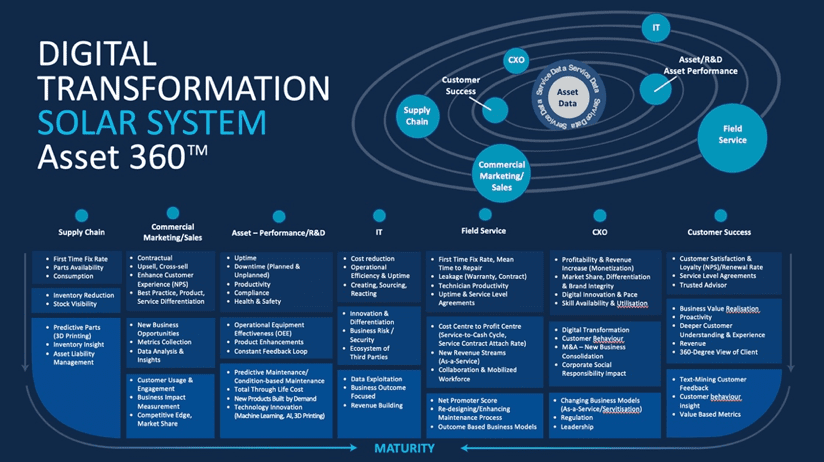Here at ServiceMax we sleep, eat, breathe, and live equipment maintenance. Over the last 13 years, this driving focus has evolved into what we call Asset Centricity. This concept, a complete view of the asset, the asset data, and how to interpret and present that data to the various consumers within a client organization, is a radical shift from traditional equipment maintenance services. Asset Centricity brings immense benefits to our customers by providing a 360° visibility into asset data, an understanding of the value of that data throughout the business, the ability to shift business models, and the tools to make it all work.
What Benefit Does Asset Centricity Provide?
Achieving Asset Centricity delivers a 360° degree view of your assets starting with accurate service data that enables you to build the foundation of a common service language. These are the ingredients necessary to transform from a reactive service provider to a partner in an outcome-based service journey.
Accurate Service Data
The beginning and most important part of an asset-centric approach is collecting accurate service data, consistently, across all assets, departments, and geographies. Whether it is manually collected by customers and/or field engineers or through remote condition monitoring, Asset Centricity is built on accurate, reliable data.
This starts with the bill of materials as received and continues through the life of an asset, but is magnified via the “As Maintained” bill of materials that captures each service activity that occurs throughout the life of the asset. This includes every service call, planned maintenance action, and part replaced—everything that has ever been done to that asset.
A Common Service Language
With accurate service data, we help our clients develop a “Common Asset Service Language” that will allow them to normalize their asset data and provide configured reports for the departments that need to utilize it. This “Common Service Language” will bridge the gap between consumers who rely on service data for equipment service requirements and those that need the data to conduct other essential business processes (i.e. Sales, Supply Chain, Manufacturing, etc.).
The chart below illustrates how each department within the organization requires service data in some form. Sales may need to know the current asset utilization before placing a call to offer upsell. Finance may need to know that there are outstanding service orders before placing a call for accounts receivable. Sales Operations may need to know the current overall status of the account before contacting the customer asking for a reference. As you can see, all departments within an organization utilize a different aspect of asset service data, and we provide them with a specific view, tailored to their requirements.

The Ability to Transition to Outcome-Based Services
A key driver of the need for Asset Centricity is the increasing requirement for businesses to shift from selling products to selling solutions and outcomes. The increase in “outcome-based” services is completely dependent on having better service data. Once you have a good understanding of the condition of your assets, how much output you can expect, and what the current maintenance costs and projected maintenance costs are, you can confidently create a business plan and pricing model to sell the output of those assets.
This puts our clients in control of their assets and business, allowing them to market and sell the output that their assets produce for a service fee, rather than sell the assets themselves. This is important in several ways.
The end-user no longer needs to become an “expert” in non-core equipment, they are just buying the availability and output of that equipment. This means that they can focus their internal resources on their business. The asset owner can now ensure that they are using the correct asset for the services required, and as demand changes, they have the flexibility to add, change, or remove assets as well as redeploy them to another customer. This creates the opportunity to continually right-size the assets dedicated to a specific client, sell available capacity to new clients, and offload un-needed assets. Most importantly, every benefit they achieve flows right to their bottom line.
How Will Asset Centricity Benefit My Business?
On top of having the data needed to effectively transition to outcome based-service models, Asset Centricity enables service organizations to:
- See the condition and operation of assets
- Schedule people, parts, and resources effectively to improve First Time Fix (FTF) and Mean Time to Repair (MTTR) rates
- Access necessary information across different interfaces such as mobile
- Share data across systems and business functions as needed
With Asset Centricity in place, organizations can take it a step further with Artificial Intelligence (AI) to enhance all phases of field service delivery starting with the technician selection and dispatch process. AI can review thousands of prior work orders on a specific asset type, “learn” what parts fixed which error codes or reported service issues, which technician skill sets were needed, and how long a maintenance activity should take. Just imagine if your planner or dispatcher opened up a work order and was presented with the following:
“There is a 95% likelihood that the following parts are needed to complete this service order; SN8735X357, SN984532V2, and SN1533DF32. Specialty tools required are; Medium torque wrench, Multi-meter, small bearing puller. This action should be completed in 1.5 hours +/- 15 mins.”
And, when they selected that work order, the system already filtered out all of the technicians who were not appropriately trained on that asset, so that the only technicians who could be assigned the work, are those that can do the work. This technology can drive significant differentiation and higher service levels while helping to control costs and reduce inventory.
All in all, the advent of Asset Centricity will help our customers transform their operations, improve their business performance in key measurable areas, manage costs more effectively, share service data across their enterprise more efficiently, and shift to more profitable business models with greater confidence. By the introduction of our Asset Centricity software, Asset 360, we are definitely helping our customers keep the world running.
To learn more about the benefits of Asset Centricity and a 360° approach, watch the on-demand replay of our Keynote here. Joined by Amit Jain and Coen Jeukens from ServiceMax, Stacey Epstein, ServiceMax CMO & CXO, discusses how you can increase uptime, reduce costs, and maintain compliance through an asset-centric approach.


Share this: